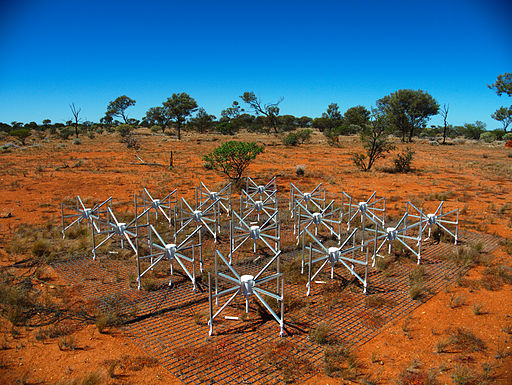New Australian Radio Telescope

A new radio telescope in Western Australia’s remote outback promises to save the world billions of dollars by providing early warning of solar storms. The Murchison Widefield Array (MWA) radio telescope, built as a Square Kilometer Array precursor project and unveiled late last year, has stared monitoring the Sun just in time for the current solar maximum. Severe storms can damage power transmission systems and destroy the delicate electronics in expensive satellites if their operators aren’t given enough time to prepare.
But the MWA has more traditional uses as well, studying distant space to better understand the history of the universe. It’s four primary areas of study are interactions between the Sun and the Earth, the early universe when matter first began condensing into stars and galaxies, the structure and evolution of galaxies, and violent and explosive phenomena throughout the universe.
Even at this early stage, MWA is giving impressive results: “Preliminary testing, using only a fraction of the MWA’s capability, has already achieved results that are on par with the best results ever achieved in the search for the first stars and galaxies. We anticipate a 10-fold improvement in performance when the full capabilities of the MWA are pressed into service in early 2013,” said Director of the MWA and Professor of Radio Astronomy at Curtin University, Professor Steven Tingay, speaking to a group of eminent scientists and VIPs who had travelled from all over the world to attend the telescope’s unveiling.
The completion of the MWA realises eight years of work by an international consortium of 13 institutions across four countries (Australia, USA, India and New Zealand), led by Curtin University.
The Murchison Radio-astronomy Observatory (MRO: operated by CSIRO) was chosen by the consortium because it is the world’s best location for low frequency radio astronomy. The site has also been selected as the future home for a major part of the Square Kilometre Array.
The Murchison Radio-astronomy Observatory (MRO: operated by CSIRO) was chosen by the consortium because it is the world’s best location for low frequency radio astronomy. The site has also been selected as the future home for a major part of the Square Kilometre Array.
Located 370 km north-east of Geraldton (nearly 800 km from Perth) the MWA is situated in the Shire of Murchison, an area of approximately 50,000 square kilometres (19,300 square miles) and has a population of 114 people. The MWA is located at CSIRO’s Murchison Radio-astronomy Observatory (MRO).
The Murchison Widefield Array will pick up radio waves that have travelled between 8 minutes (the Sun) and more than 13 billion years (soon after the Big Bang) to reach Earth.
The telescope spans a 3 diameter kilometre area and is entirely static (no moving parts). It uses 2,048 dual-polarisation dipole antennas arranged into a strategic formation of 128 groups (16 dual-polarisation dipoles per group).
Each of these antennas has been constructed from a flat-pack style design and built in-situ at the MRO by a team of undergraduate students from Curtin University, known as the Student Army.
The telescope is considered low-cost, with each antenna costing approximately $3,000. Comparatively a high frequency dish telescope costs in the region of $500,000.
Radio waves collected from the sky are digitised, producing a new image of the sky every few seconds. These are then sent via high speed optical fibre, an early part of the National Broadband Network, to a processing and archiving facility over 700 kilometres away in Perth (the $80m Pawsey HPC Centre for SKA Science).
When operating at full capacity the telescope will produce the equivalent of a 2 hour long HD movie every 10 seconds (approximately 4 GB every 10 seconds).
Technology giants IBM and Cisco, as well as Western Australian based firm Poseidon Scientific Instruments (acquired by Raytheon in July 2012), have worked with the consortium to create highly specialised hardware to process the vast amount of data created by the telescope.
The primary archiving facility will be the $80million Pawsey HPC Centre for SKA Science, which is being built in Perth. Information is also being automatically transferred to MWA partner organisations in Boston in the United States (MIT) and Wellington in New Zealand (Victoria University of Wellington).
The Murchison Widefield Array will pick up radio waves that have travelled between 8 minutes (the Sun) and more than 13 billion years (soon after the Big Bang) to reach Earth.
The telescope spans a 3 diameter kilometre area and is entirely static (no moving parts). It uses 2,048 dual-polarisation dipole antennas arranged into a strategic formation of 128 groups (16 dual-polarisation dipoles per group).
Each of these antennas has been constructed from a flat-pack style design and built in-situ at the MRO by a team of undergraduate students from Curtin University, known as the Student Army.
The telescope is considered low-cost, with each antenna costing approximately $3,000. Comparatively a high frequency dish telescope costs in the region of $500,000.
Radio waves collected from the sky are digitised, producing a new image of the sky every few seconds. These are then sent via high speed optical fibre, an early part of the National Broadband Network, to a processing and archiving facility over 700 kilometres away in Perth (the $80m Pawsey HPC Centre for SKA Science).
When operating at full capacity the telescope will produce the equivalent of a 2 hour long HD movie every 10 seconds (approximately 4 GB every 10 seconds).
Technology giants IBM and Cisco, as well as Western Australian based firm Poseidon Scientific Instruments (acquired by Raytheon in July 2012), have worked with the consortium to create highly specialised hardware to process the vast amount of data created by the telescope.
The primary archiving facility will be the $80million Pawsey HPC Centre for SKA Science, which is being built in Perth. Information is also being automatically transferred to MWA partner organisations in Boston in the United States (MIT) and Wellington in New Zealand (Victoria University of Wellington).
